Accompanying persons
May 26th, 2011
Sanzoku & Kintaikyo Bridge Tour(10:30-17:00)
*Tour Fee --- 5,000JPY
International Conference Center Hiroshima/Hotel --- Sanzoku -- Kintaikyo Bridge --- International Conference Center Hiroshima/Hotel
May 28th, 2011
Shimanami Kaido Expressway Tour(10:30-17:40)
http://www.go-shimanami.jp/english/index.html
*Tour Fee --- 5,000JPY
International Conference Center Hiroshima/Hotel --- Ohmishima/Oyamazumi Shrine --- Setoda/Ikuo Hirayama Museum of Art --- International Conference Center Hiroshima/Hotel
Sanzoku & Kinkaukyo Bridge Tour
Sanzoku
Lunch Time
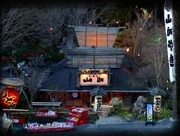 Designed as an old traditional Japanese house and located in Yamaguchi Prefecture, Sanzoku is a restaurant that incorporates traditional folk crafts, enabling the visitor to truly understand Japanese culture and the Japanese soul.
Designed as an old traditional Japanese house and located in Yamaguchi Prefecture, Sanzoku is a restaurant that incorporates traditional folk crafts, enabling the visitor to truly understand Japanese culture and the Japanese soul.
The unusual Japanese-style space creates a sense of traveling back in time to Japanese folk tales, and visitors can enjoy the food as well as the relaxing time spent there.
Kintaikyo Bridge
Designated as a Japanese place of scenic beauty in 1922.
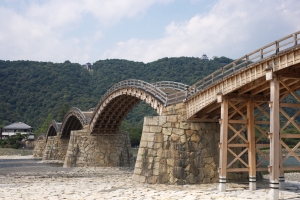 The bridge was first constructed by the third lord of Iwakuni domain, Hiroyoshi Kikkawa, in 1673, and the current bridge is the fourth generation of the bridge since that time. This wooden arch bridge built over Nishiki River in Iwakuni City, Yamaguchi Prefecture, is counted as one of the three great bridges and the three unusual bridges in Japan. The bridge, with a length of 193.3 meters and a width of 5.0 meters, is made of five continuous arches, and was constructed using wood building techniques such as coupling and joints. However the beautiful arch forms are not only made of wood. They were made possible by the effective use of iron (steel). The bridge was built based on hints gained from the bridge spanning the banks of Si Hu (West lake) in Hangzhou, China.
The bridge was first constructed by the third lord of Iwakuni domain, Hiroyoshi Kikkawa, in 1673, and the current bridge is the fourth generation of the bridge since that time. This wooden arch bridge built over Nishiki River in Iwakuni City, Yamaguchi Prefecture, is counted as one of the three great bridges and the three unusual bridges in Japan. The bridge, with a length of 193.3 meters and a width of 5.0 meters, is made of five continuous arches, and was constructed using wood building techniques such as coupling and joints. However the beautiful arch forms are not only made of wood. They were made possible by the effective use of iron (steel). The bridge was built based on hints gained from the bridge spanning the banks of Si Hu (West lake) in Hangzhou, China.
In 2004, Kintaikyo Bridge became a sister bridge of Si Hu’s Kintaikyo Bridge, and currently a stone monument has been erected on its bank to commemorate the Kintaikyo Friendship.
Shimanami Kaido Expressway Tour
Ohmishima
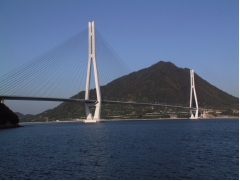 Ohmishima is one of the inhabited islands in the group of islands known as the Geiyo islands, in Imabari City, Ehime Prefecture. Located at the northernmost point of Ehime Prefecture, it is that prefecture’s largest island, and is also designated as one of Japan’s beauty spots.
Ohmishima is one of the inhabited islands in the group of islands known as the Geiyo islands, in Imabari City, Ehime Prefecture. Located at the northernmost point of Ehime Prefecture, it is that prefecture’s largest island, and is also designated as one of Japan’s beauty spots.
Housing Oyamazumi Shrine, Ohmishima is known as a ‘sacred island’. There are Japanese traditional inns, souvenir shops and restaurants located in the area, and of the Geiyo islands, Ohmishima ranks alongside of Ikuchijima Island and Setoda as a major tourist destination.
In the sea off the east coast of Ohmishima are the ruins of an outpost castle of historical naval forces. It is said that this outpost was built during the time of Emperor Tenji to protect against invasion by Tang Dynasty forces, and is Japan’s oldest naval fortress. During low tide, it is possible to walk there from Ohmishima along the sandbar.
Oyamazumi Shrine
As the home of the god Oyamazumi, this is the head shrine of Yamazumi Shrines and Mishima Shrines throughout Japan.
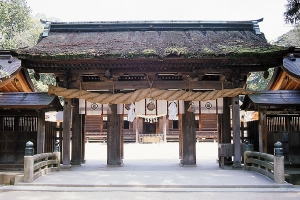 The shrine contains eight national treasures and 75 important cultural properties (current as of 2008), and also includes a national natural monument, the Oyamazumi Shrine camphor trees. As home to the mountain gods, sea gods and gods of battle, this shrine has been the subject of worship by past Imperial courts as well as military commanders. Many military commanders, including those in the Genji and Heike clans, donated weapons to the shrine and prayed for long-lasting good fortune in war. Consequently, approximately forty percent of the Japanese armor that has been designated as a national treasure or important cultural asset is found at this shrine.
The shrine contains eight national treasures and 75 important cultural properties (current as of 2008), and also includes a national natural monument, the Oyamazumi Shrine camphor trees. As home to the mountain gods, sea gods and gods of battle, this shrine has been the subject of worship by past Imperial courts as well as military commanders. Many military commanders, including those in the Genji and Heike clans, donated weapons to the shrine and prayed for long-lasting good fortune in war. Consequently, approximately forty percent of the Japanese armor that has been designated as a national treasure or important cultural asset is found at this shrine.
It is clear that this shrine has existed since very ancient times. In the Heian Period it was awarded the Nihon Sochinju designation from the Imperial court.
Ikuo Hirayama Museum of Art
‘Hirayama art’
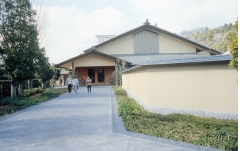 Ikuo Hirayama Museum of Art is located in Setoda Town, Hiroshima Prefecture, one of the main tourist destinations on Setouchi Shimanami Kaido that links Onomichi on the mainland with Shikoku’s Imabari.
Ikuo Hirayama Museum of Art is located in Setoda Town, Hiroshima Prefecture, one of the main tourist destinations on Setouchi Shimanami Kaido that links Onomichi on the mainland with Shikoku’s Imabari.
The painter Ikuo Hirayama is one of Japan’s most famous artists. Born in Setoda Town in 1930, he grew up in the great nature of Setouchi. His sensitivity as an artist was most surely nurtured in this environment.
This art gallery provides a complete introduction to Mr. Ikuo Hirayama’s great works to date. In addition to displays of his latest works, there is also an introduction to his upbringing, precious paintings from his youth, as well as sketches, draft works, high-vision images and more, all providing opportunities to experience ‘Hirayama art’.
What's New
'11.05.16…Final Abstract Book
'11.05.16…Final Program and Schedule
'11.04.14…The early registration is extended to April 25th.
'11.03.31…From the President
'11.03.31…The early registration is extended 2 weeks.
'11.03.22…Program and schedule (draft1)
'11.01.31…Research Award Finished
'11.01.31…Submit Abstract Closed
'11.01.13…Deadline for Abstract Acceptance
'10.11.15…Travel Grants Finished
'10.11.04…Registration Online
'10.11.04…Social Program
'10.11.04…Accompanying
'10.11.04…Post Congress Events
'10.10.15…Invited Speakers
'10.09.01…Congress
'10.09.01…Travel Grants
'10.09.01…Registration Info
'10.06.29…Deadlines and Updates
'10.05.10…Introduce Hiroshima
'10.04.19…Introduce Hiroshima
'10.02.05…update
About the concept of
18th ICDMFR
The main stream of the concept of this logo is the flag of Japan. Red and white are used. The right IADMFR logo is imaged as the red center circle of Japanese flag, which means the sun. The sunshine pours a lot of radiations. In the white background, you can see a dove and Torii. Torii is a Japanese word, which means a gate of a shrine. This Torii is the symbol of Miyajima, one of the 2 world heritages in Hiroshima. Miyajima is the name of a holly island, which has Itsukushima Shinto Shrine, the main attraction of Aki no Miyajima, long known as one of Japan's "three beauty spots.
The LOGO means “Radiation and Peace” in Hiroshima!







